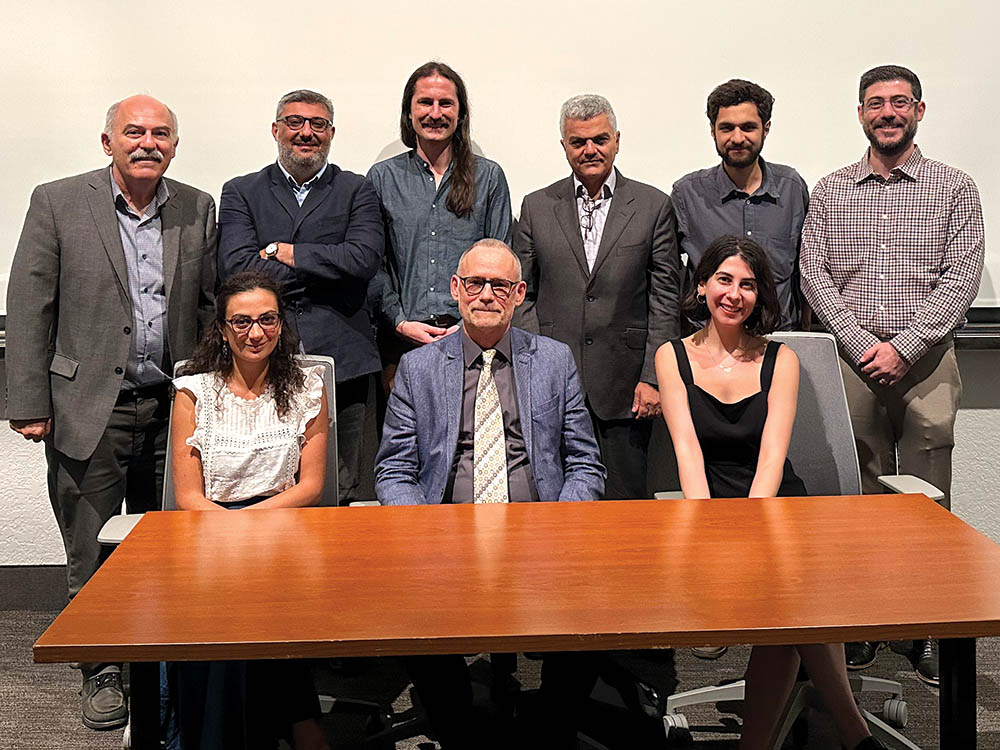Often, history is approached through a macro-lens. It address-es mass issues within a large population from a social, socioeconomic, cultural, or political standpoint. Yet, this broad prospect may undermine the importance and purpose of microhistory. Microhistory has a different role in the academic field. It provides a refined, niche perspective on an otherwise conventional topic, and delves into a profound understanding of an individual group of people or series of events.
The Armenian Studies Program organized a two-day international conference, “Microhistories in Armenian Studies,” on the Fresno State campus. The conference was organized by Prof. Barlow Der Mugrdechian and Dr. Ümit Kurt and was financially supported by the Florence Elaine Hamparson Memorial Fund.
The conference featured a keynote speech by Hans-Lukas Kieser (Univ. of Newcastle, NSW) and six presentations: Victoria Abrahamyan (University of Neuchâtel), Ara Sarafian (Gomidas Institute), Sam Dolbee (Vanderbilt University), Robert Sukiasyan (Yerevan State Univeristy, the American University of Armenia, and the Shoah Foundation), Ümit Kurt (University of Newcastle, NSW), and Hazal Özdemir (Northwestern University).
Fresno State President Dr. Saúl Jiménez-Sandoval opened the conference and provided a statement of support to the Armenian community in light of the war in Artsakh.
Each scholar in the conference presented a niche area of research in the field of Armenian Studies. “The Armenian Studies Program is important in generating information, awareness, and preservation of the Armenian culture to Armenians and non-Armenians,” said Ara Sarafian.
“Scholars cannot change the past, but can change the understanding of the past,” said keynote speaker Hans-Lukas Kieser. His presentation was titled, “Genocide in the Mind: Minister Rıza Nur’s Travesty of Armenian History.” Keiser narrowed in on one particular perpetrator of the Armenian Genocide, Minister Riza Nur, and how his political cohort “made violence against Armenians a norm.” Keiser pointed out how Nur and his cohort were keen to manipulate the words and actions of the CUP (Committee of Union and Progress) against minority groups. Their motive and belief, according to Nur, was that “the Armenian [was like] a malignant tumor in our body and needed to be removed by a surgical operation.”
“The Contested Armenian Participation in the Syrian Great Revolt, 1925-1927” was the topic of Victoria Abrahamyan’s presentation, which covered the role of the Armenian community in Damascus in this period. Thousands of refugee Armenians had settled in Syria after World War I and the loyalty of these refugees was questioned amidst post-War uncertainties, the formation of the Syrian state under French tutelage, and the frustrated attempts to create an independent Arab state.
Ara Sarafian focused on the Armenians in Kharpert in 1880 in his presentation “Levon Gjigian, Leslie A. Davis, and Armenian resistance at Morenig, 1915.” His presentation explored the significance of memoirs in the study of Armenian history, in particular the memoir of Levon Gjigian.
Samuel Dolbee, impressed by the “strong Armenian community” in Fresno, spoke on “Hovhannes Doumanian and the Last Ottoman Agronomists.” As a professor of climate studies, his work investigates how the deportations of Armenians impacted the region from an agricultural standpoint, as well as the “involvement of Armenians in Turkish agriculture.” Utilizing the memoirs of master agronomist Hovhannes Toros Doumanian, who trained other Armenians in agronomy, Dolbee concluded that most agronomists in the region were Armenian. As a result of the deportations, an era that Dolbee and other scholars refer to as the “Ottoman Twilight,” there was no one to maintain the crops and waves of locusts began eating the crops. This also resulted in the spread of malaria in the region.
On Saturday, September 23, the conference opened with “A Scheme for Extortion and Targeted Eliminations of Surviving Sivas Armenian Community Leaders in the Summer of 1915,” by Robert Sukiasyan.
His presentation was divided into four sections: an overview of Armenian, Ottoman, and Missionary sources; the situa-tion in the Sivas/Sepastia provinces prior to the Armenian Genocide; the organization of the deportations; and the deportation station of Kötü Han on the border of Sivas. Sukiasyan’s Armenian sources included eyewitness and research accounts from Garabed Kapikian and Aram Andoian in the mid-1800s.
These sources unveil the Turkish system’s attempt to deport and eliminate the Armenian elite.
They present aspects of the Armenian deportations that were absent or removed from official documents, contributing to the ethnic cleansing of Armenians that continues today.
Sukiasyan’s paper further divulges into the methods of valuable extractions, security commissions, targeted indi-viduals, and elimination methods.
“It is important to show that financial exploitation is happening at the state level,” asserted Ümit Kurt during his presentation “The Fate of Armenian Family Wealth: Confiscation of Property in Ottoman Aintab during the First World War.” Kurt discovered quotes on the deportation from Harutyun Nazarian, as evidence of the transactions proving that the Aintab Liquidation Commission participated in “state burglary.” These quotes include the item, quantity, price, and buyer of each transaction. Kurt’s findings show “how mobile and immobile properties were auctioned by the Aintab Liquidation Commission during the deportations and Genocide.”
Hazal Özdemir’s talk was on “Undesirable Subjects In and Out of the Empire: Mobility, Nationality and Un-Making of an Ottoman Subject,” which focused on “Ottoman subject un-making.” Armenians during the reign of Abdul Hamid II were often encouraged to leave the Empire, under the condition that they sign documents renouncing their Ottoman citizenship. Özdemir also investigated the question of violence, “to investigate how the government utilized administrative and legal tools to set boundaries for Ottoman citizenship.”
The methodological approach of micro-historical studies paves the way for the marginalized voices to be heard and their stories to be told. The individual papers presented by each scholar generated a sense of unity among Armenians, as they could learn of the deeper history of their people.
The full conference proceed-ings are archived on the Armenian Studies Program YouTube channel. Day 1– https://www.youtube.com/live/rlqALVvI6FE?si=BpNUXiGS91NfbVcKand Day 2 – https://www.youtube.com/live/03zpxtSnvWs?si=qYlyA8u1ZHr7kyp9. rlqALVvI6FE?si=pZfBXbUFUA6EQZrD and Day 2 – https://www.youtube.com/live/03zpxtSnvWs?si=qYlyA8u1ZHr7kyp9.




